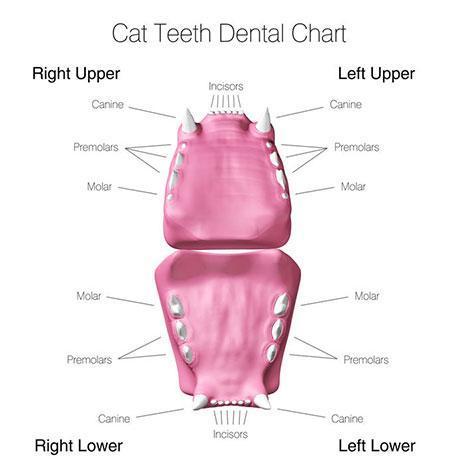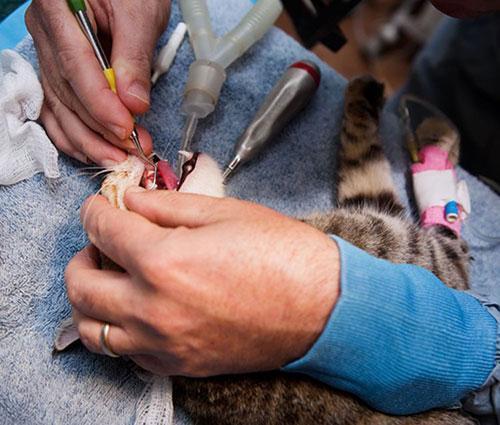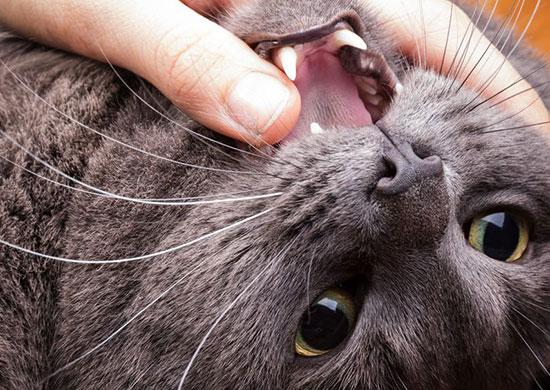This content is archived from the Feline Nutrition Foundation
Open Wide: The Basics of Kitty Dentals
- Updated: Friday, May 03, 2019 05:18 PM
- Published: Saturday, October 06, 2018 04:00 PM
- Written by Guillermo Díaz. MV
Periodontal disease has become of the most prevalent diseases in small animal practice since the advent of commercial pet foods. At the same time, it is one of the least diagnosed and least treated diseases of companion animals. Periodontal disease is the inflammation of the structures that give support to the teeth. This includes the soft tissue, as in the gums, and the hard tissue, the maxillary and mandibular bones. These bones have a series of holes, one for each tooth, lined up in a row. The teeth are firmly attached to the roots and the periodontal ligaments – microscopic fibrous bands that hold the roots to the alveolar bone – keep them in place.
Cats have two sets of teeth: deciduous and permanent. Deciduous teeth begin to emerge around two to three weeks of age and permanent teeth erupt at three to four months. Adult cats have 30 teeth. They have a smooth surface with the shape varying according their function. The different types of teeth are: the incisors – the tiny ones at front of the mouth, the canines – with a knife-like appearance, premolars and molars – the triangular shaped side teeth. Cats have in the upper jaw: six incisors, two canines, six premolars and two molars. In the lower jaw: six incisors, two canines, four premolars and two molars.

When cats are fed a species-inappropriate diet such as dry kibble, the high load of carbohydrates promotes the formation of plaque. This is a combination of sugars, minerals and bacteria that adheres to the surface of the teeth. If teeth remain uncleaned, the next stage is the buildup of tartar or calculus which contains millions of bacteria in a permanent reproductive state, releasing to the bloodstream deleterious by-products. Despite its name, periodontal disease not only damages the teeth and mouth but the whole body, affecting liver, kidneys, lungs, heart and bones.¹
Wild big cats and smaller cats in the wild hardly ever get periodontal disease. The reason for this relies on the food they eat: raw meat, bones and organs.² If wild cats, big or small, don't have a human around to brush their teeth, how is it possible for them to get a dental brushing every day and have neat and shiny teeth?
Mother Nature designed cats' teeth to be cleaned while eating. By ripping and tearing the carcasses, flipping them from side to side, chewing the meaty bone with their molars and premolars, these felines get the best workout for their teeth and gums. This is the equivalent of flossing, brushing and "squeegeing," all in one go. This mechanism scrubs away any plaque and tartar, additionally providing the felines a powerful physical and mental stimulus that enhances their immune system, bringing antibodies and several other humoral factors to the mouth that help to protect the oral cavity.
The formation of plaque begins with the development of an acquired pellicle on the enamel of the teeth. On any clean tooth surface (i.e. immediately after a dental scaling and polishing) an invisible glycoprotein layer, the pellicle, begins to form within a few seconds of exposure to saliva. Within 24 hours a smooth layer of plaque covers the entire tooth, except if removed by natural dietary abrasion. As days, weeks and months pass by, the color of the plaque goes from being invisible or transparent, to yellowish or brownish.
If your cat has been eating commercial dry kibble, she will likely need a dental checkup and probably a dental cleaning. This procedure is typically just called a "dental" for short. Both involve the risk of anesthetics. In order to make sure your kitty is in optimal condition, the veterinarian will pull blood and perform a CBC, a complete blood count, and a biochemistry panel looking for the optimal values primarily of the kidneys and the liver, which are the organs that will detoxify the anesthetics from your cat's body. According to these results, cats with normal blood values are suitable to undergo anesthetics. Cats with abnormal values, mainly from kidneys and liver, will have to wait and be physiologically compensated – perhaps with fluids and medication – for further re-check of the blood. Regrettably, cats with advanced stage kidney disease will never be candidates for a safe sedation and anesthetics.

During the exam, under anesthesia, the veterinarian will thoroughly examine each tooth, assessing for redness, swelling and bleeding in the gums and will also check for mobility of the teeth. With a device called a dental probe, the doctor will measure the depth of each dental pocket – the space between the base of the tooth and the gum adjacent to it – to measure and rate the progression of the periodontal disease. Finally, if needed, some X-rays will be taken in order to assess the integrity of the roots and to evaluate and rate the progression of the periodontitis. All of the findings during the checkup under anesthesia will be recorded on a dental chart and attached to you kitty's medical history.
During the dental cleaning procedure, all of the plaque and tartar built up in the mouth is removed by ultrasound. If needed, tooth extractions will be performed at this time. Manual scaling or scraping is commonly used in order to remove plaque buildup below the gum line. For cats with non-advanced periodontitis, the cleaning may last for about 20 to 40 minutes. If the patient requires more treatment than just a cleaning or any necessary tooth extractions, it will require more time. The aftercare for a standard cleaning may include soft food for the next day after the procedure. There is no need for antibiotics if a cat presents with gingivitis only. Conversely, cats with periodontitis, inflammation and infection of the gum and bones, do require antibiotics during and after the procedure.
Cats don't get cavities as people do because of the unique and different buccal ecology of each species and the shape of the teeth. However, there's a condition called Feline Odontoblastic Resorptive Lesions which some authors consider to be a form of feline cavities. In this case, tooth extraction is the treatment of choice due to pain and progression of the disease.³
It is important that owners learn to recognize the signs that suggest periodontal disease in their feline companions by noticing any redness of the gums, change of color of the teeth, bad breath or pain, which might be indicated if the cat stops eating. If any of these symptoms occurs, a visit to your vet is needed.
Additional Reading
Chunks and Bones For Your Cat's Teeth
Tell Your Cat to Chew on This!
Keep in mind that the risks involved in the use of anesthetics and the financial and emotional burden a dental procedure implies could be avoided by the simple act of feeding your obligate carnivore species-appropriate food. Many cats that eat whole foods that are challenging – raw meaty bones, larger meat chunks or whole prey – will never need a dental cleaning. They are in essence "brushing" their teeth every day with the foods they eat.
Dr. Guillermo Díaz and family, including their four dogs (Leroy, Xica, Moza and Pepa) and six cats (Michalina, Tigger, Vladimir, Yellow, Mongo and Chirusa) moved to Buenos Aires, Argentina in July of 2017, where he expects to continue supporting different animal rescue groups, spread the benefits of raw food for cats and dogs and write articles about nutrition.
1. NJ Cave, JP Bridges and DG Thomas, "Systemic Effects of Periodontal Disease in Cats," Veterinary Quarterly, vol. 32, no. 3-4, Nov 2012, 131-144.
2. David A Fagan, D.D.S. and Mark S. Edwards, Ph.D., "Influence of Diet Consistency on Periodontal Disease in Captive Carnivores," Zoological Society of San Diego, Department of Veterinary Services.
3. "Can Cats Get Cavities?" Canadian Veterinary Medical Association, April 2012.





